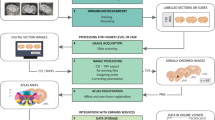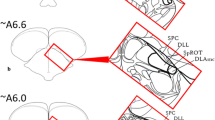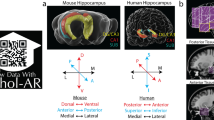Abstract
IN the course of studies of the hypothalamus of the rhesus monkey, we have investigated a restricted area of specialized ependymal cells. This area lies anterolaterally in the tuber cinereum (see Fig. 1), and is distinguished by the long processes of the ependymal cells which extend to the region of the pars tuberalis; neighbouring ependymal cells are cuboid, without processes. The elongate ependymal cells stain deeply with the Gomori chrome–alum–haematoxylin technique and may be followed with ease using the optical microscope. They are not evident after silver impregnation techniques (Bodian's silver protargol method or Bielschowsky's technique), nor are they detectable after performic acid–alcian blue staining; they can, however, be demonstrated by cresol fuchsin and aldehyde fuchsin and the periodic acid–Schiff (PAS) method.
This is a preview of subscription content, access via your institution
Access options
Subscribe to this journal
Receive 51 print issues and online access
$199.00 per year
only $3.90 per issue
Buy this article
- Purchase on Springer Link
- Instant access to full article PDF
Prices may be subject to local taxes which are calculated during checkout
Similar content being viewed by others
References
Leveque, T. F., and Hofkin, G. A., Anat. Rec., 142, 252 (1962).
Knowles, F., and Vollrath, L., Phil. Trans. Roy. Soc., B, 768, 311 (1966).
Knowles, F., Proc. Fourth Intern. Symp. on Neurosecretion (Springer, in the press).
Author information
Authors and Affiliations
Rights and permissions
About this article
Cite this article
ANAND KUMAR, T., KNOWLES, F. A System linking the Third Ventricle with the Pars Tuberalis of the Rhesus Monkey. Nature 215, 54–55 (1967). https://doi.org/10.1038/215054a0
Received:
Issue Date:
DOI: https://doi.org/10.1038/215054a0
This article is cited by
-
Seasonal variations in the cerebrospinal fluid-contacting area of the pineal gland in the golden hamster (Mesocricetus auratus)
Anatomy and Embryology (1984)
-
Incorporation of [3H] estradiol into elements of tanicytic and ciliary ependyma of third ventricle of brain in vitro
Neuroscience and Behavioral Physiology (1980)
-
The role of tanycytes in the mechanisms of sexual differentiation of the brain
Neuroscience and Behavioral Physiology (1978)
-
Ovulation in rhesus monkeys suppressed by intranasal administration of progesterone and norethisterone
Nature (1977)
-
Ultrastructural studies of the granulosa and the diencephalic ependyma in rats
Proceedings / Indian Academy of Sciences (1975)
Comments
By submitting a comment you agree to abide by our Terms and Community Guidelines. If you find something abusive or that does not comply with our terms or guidelines please flag it as inappropriate.



